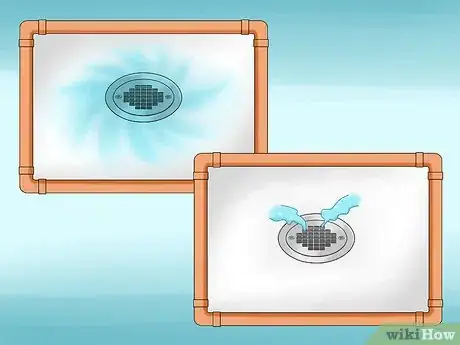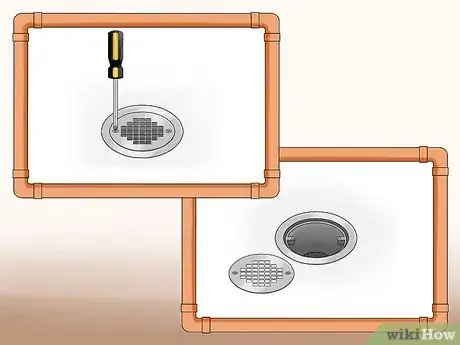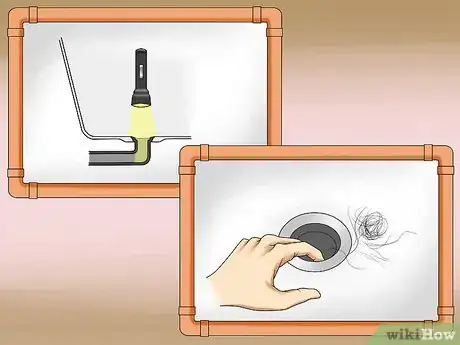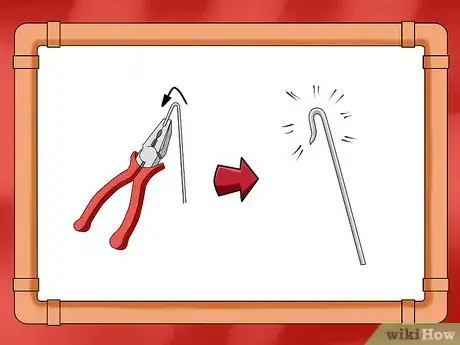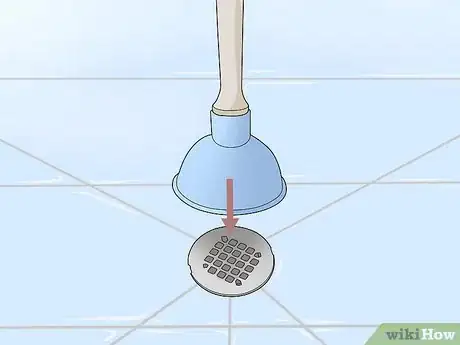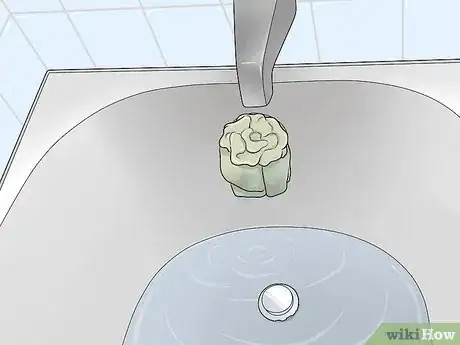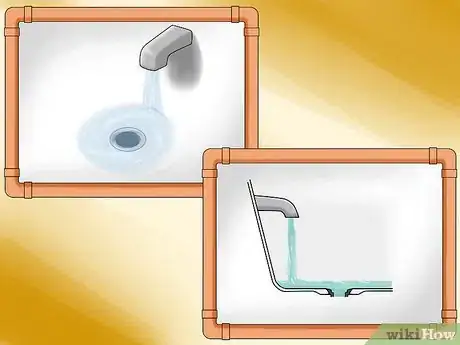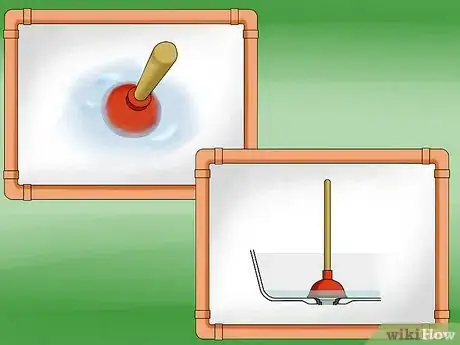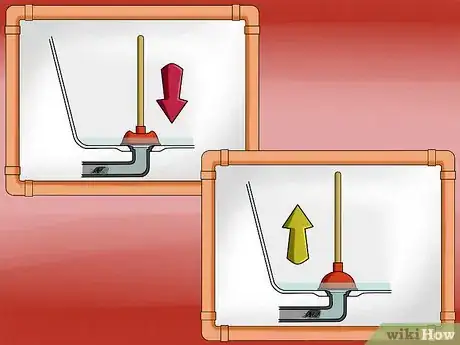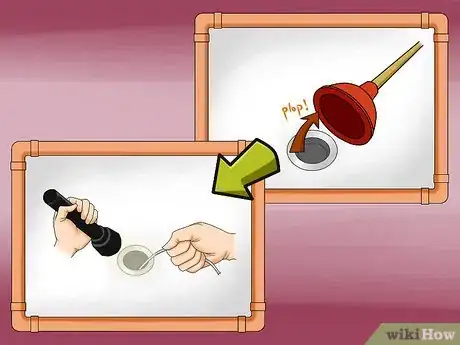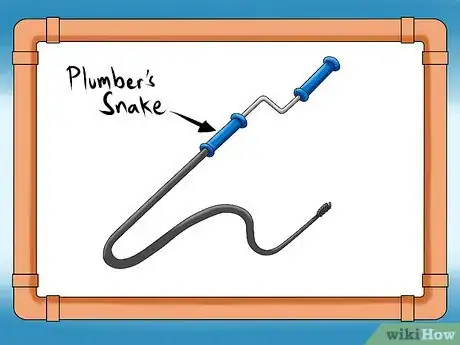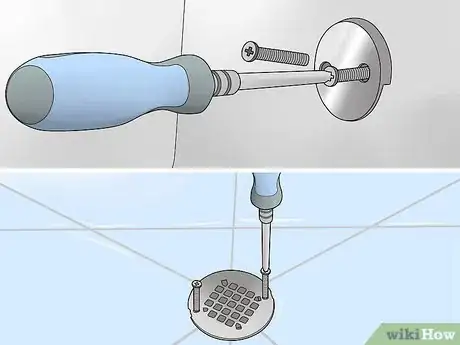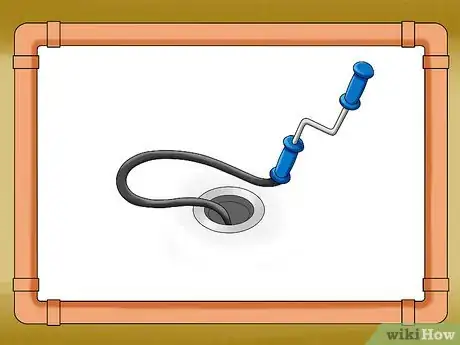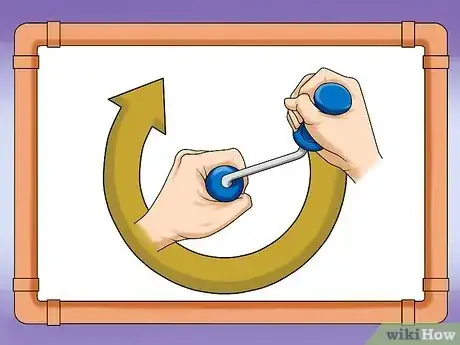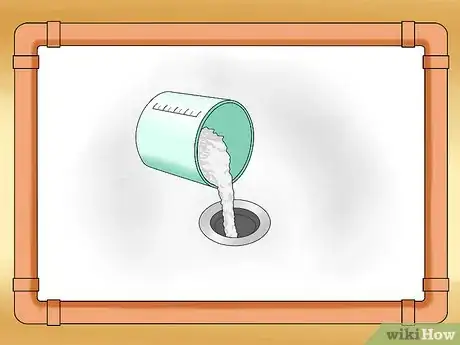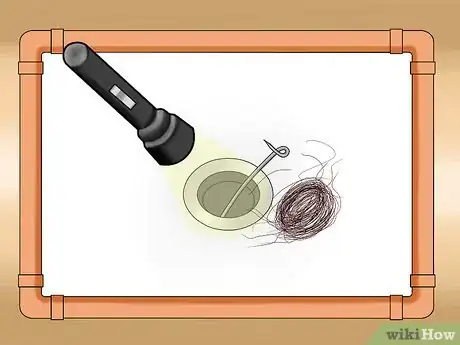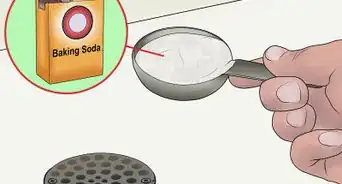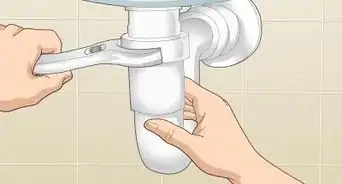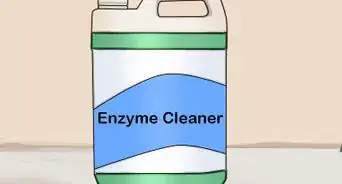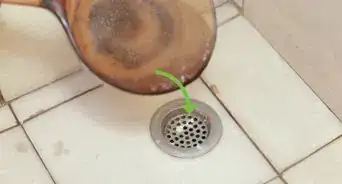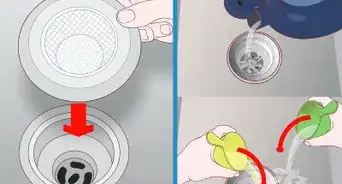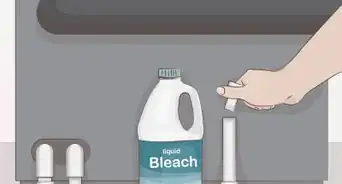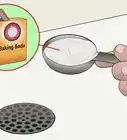This article was co-authored by James Schuelke. James Schuelke, along with his twin brother David, is the co-owner of the Twin Home Experts, a licensed plumbing, leak detection, and mold inspection company based in Los Angeles, California. James has over 32 years of home service and business plumbing experience and has expanded the Twin Home Experts to Phoenix, Arizona and the Pacific Northwest.
wikiHow marks an article as reader-approved once it receives enough positive feedback. In this case, 80% of readers who voted found the article helpful, earning it our reader-approved status.
This article has been viewed 761,111 times.
Shower drains can become clogged with minerals from hard water, hair, and soap. Most of the time, hair is the culprit causing the clog and you can easily remove it by pulling it out with your hands. If that doesn't do the trick, try using a wire hanger, a plunger, or a hand snake. If none of those solutions work, try a mixture of baking soda and vinegar. In the majority of cases, one of these solutions will work, but if they don't, call a plumber.
Steps
Pulling out Superficial Clogs with Your Hands
-
1Wait for several minutes after showering so that the water can drain. It will be easier to remove a clog if the pipes are free of water. If the water doesn't drain, you may need to try plunging or snaking.[1]
-
2Use a screwdriver or your hands to remove the drain stopper. If you have a strainer that is attached with screws, use a screwdriver to remove it. Some drain covers simply lift out or can be unscrewed with your hands. Put the cover in the open position and remove any screws that need to be undone. Then lift the cover out.[2]
- If you have a drop stopper, lift the stopper and find the screw at tub level. Unscrew it and the top section of the device.
Advertisement -
3Remove surface level clogs by hand. Most clogs are caused by hair. If the hair is sitting near the surface, just pull it out with your fingers.[3]
- Wear rubber gloves if you don't want to touch the hair with your bare hands.
EXPERT TIPJames Schuelke, along with his twin brother David, is the co-owner of the Twin Home Experts, a licensed plumbing, leak detection, and mold inspection company based in Los Angeles, California. James has over 32 years of home service and business plumbing experience and has expanded the Twin Home Experts to Phoenix, Arizona and the Pacific Northwest.Professional Plumber
 James Schuelke
James Schuelke
Professional PlumberIf you have a wet/dry vacuum, you can use that, instead. Take the drain cover off the shower, then put your wet/dry vacuum hose right up against the drain. When you turn the vacuum on, it will extract any organic matter, hair, soap scum, and anything else that's inside that drain.
Using a Wire Hanger
-
1Unwind and straighten a wire hanger and create a hook at the end. Use a pair of needle-nose pliers to unwind the loops and straighten out the wire as much as possible. Create a small hook about 1⁄4 inch (0.64 cm) long at the end of the wire to make it easier to catch hair. A wire snake will be able to reach clogs that are deeper than those you can reach with your hands. [4]
- If you don't have a wire hanger, you can also purchase a plastic drain snake with a hook at the end designed to pull out hair. Find these at the hardware store.
- Wear rubber gloves to protect from scratching yourself with the wire and to grab any clogs you pull up without touching them with bare skin.
-
2Reach the wire snake into the drain, hook clumps of hair, and pull them up. Hold a flashlight with one hand to be able to see where the clogs are. Reach the wire snake into the drain with the hook side down, targeting any large clumps of hair. Wiggle the wire around so that it goes deeper into the drain. Feel for it to hook onto the clog and pull it out.[5]
- If the hair clog is tight enough to block water, it will stick together as you pull it up. You may have to repeat the process several times to pull out all of the pieces of the clog.[6]
-
3Turn on the hot water to tell if the clog is gone. If water runs straight down the drain, you're all set. You can put the drain cover back on and use the shower normally.[7]
- If the water still doesn't drain, there is another clog deeper down in the drain and you will need to plunge, use a hand snake, or make a baking soda and vinegar solution.
Plunging Shower Drains
-
1Use a cup plunger for shower drains if standing water won't drain. A plunger with a simple rubber cup attached to a wooden handle is the best tool for the job. If you have a flange plunger with an extra ring of rubber around the bottom, fold the extra ring into the cup.[8]
- The plunger will bring up whatever is clogging the drain. Don't use a plunger if you've poured toxic chemicals like bleach down the drain, as it will bring these up, too. They can splash and cause burns.
-
2Block the overflow drain with a wet towel. If you have an overflow drain in your tub, this can break the suction created with a plunger. Make sure it is completely closed off by covering it with a wet towel.[9]
-
3Moisten the outside of the drain with water or petroleum jelly if it is dry. The outside of the drain may be wet from a recent shower. If it is not evenly wet, pour some water into the tub. Or, use a small amount of petroleum jelly around the edge of the cup of the plunger to get a better seal.[10]
-
4Press the plunger around the drain to cover it completely. If there is a lot of standing water in your tub, remove some of it with a bucket before you start to plunge. This will keep it from splashing you. [11]
- The cup will seal when you start to pump.
-
5Start to pump the handle of the plunger gently, and then with more force. Move the handle up and down a few times to force air out. Then push vigorously for about 20 seconds.[12]
- Don't push so hard that you break the seal.
-
6Lift up the plunger and remove any material you can reach. If the plunging worked, it will have brought up whatever was clogging your drain. Remove the clog with your hands or use a wire snake if you can't reach it. Use a flashlight to get a good look.[13]
- To check that everything has been cleared out, turn on the water and watch to see if it drains. If the water doesn't drain, try using a hand snake or baking soda and vinegar solution.
Unclogging the Drain with a Hand Snake
-
1Purchase a hand snake at your local hardware or home improvement store. A plumber's snake, or cable auger, is a long cable attached to a hand crank. You can find them in lengths from 25 to 100 feet (7.6 to 30.5 m). Go for a longer length for a shower drain.
- Use a hand snake after you've already tried a wire snake and plunging.
-
2Remove the overflow plate and drain cover. Remove the drain cover with a screwdriver or by lifting it out with your hands. Also remove the overflow plate. You will either need to unscrew the plate from the tub with a screwdriver or with your hands, if there is a knob.[14]
- Removing the overflow plate will bring up the stopper linkage. Pull this out as well.
-
3Feed the snake into the overflow drain until you feel resistance. Push the wire forward by turning the hand crank counterclockwise. Once you feel resistance, you have reached the clog. Try pushing harder until you are sure the cable can't go forward anymore.[15]
- The end of the cable will latch onto the hair in order to bring it up.
-
4Turn the crank on the hand snake in a clockwise direction to pull the snake out. This will reel in the cable and bring up any clogs with it. You can remove the clog from the end of the wire with your hands.[16]
- Call a plumber if you think the clog might be caused by a larger object caught further down in the pipe that you can't reach with a hand snake.
Making a Baking Soda and Vinegar Solution
-
1Pour a pot of hot water down the drain. If you just took a shower, wait until any soapy water has drained. Heat a saucepan or kettle full of water until it reaches boiling. Then, pour the boiling hot water down the drain. [17]
- Hot water will flush the drain and prepare it for the baking soda mixture.
-
2Pour 3/4 cup (292 g) of baking soda down the shower drain. Dump the baking soda directly into the drain. Let it sit for a few minutes to make sure all of the dry powder has settled into the drain.[18]
-
3Pour 1/2 cup (118 mL) of distilled white vinegar down the drain followed by 1/2 cup (118 mL) of hot water. The vinegar will immediately react with the baking soda and start to bubble. Use the hot water to flush as much of the vinegar back into the drain as you can.
- Alternatively, you can mix the baking soda and vinegar in a measuring cup and pour it immediately down the drain. Be sure to add hot water to flush the mixture down the drain.[19]
-
4Plug the drain with a rubber stopper while the chemical reaction takes place. Allow it to sit for at least 1 hour, or overnight if you can. The fizzing will help remove any grime that has been building up.[20]
- The longer you leave the mixture in the pipes, the more buildup it will be able to dissolve.
-
5Pour more hot water down the drain. Boil approximately 2 to 4 cups (0.5 to 1 L) of water. Remove the stopper, then pour the contents of the kettle down the shower drain at once. The water should remove the clog.
- You can also turn on the hot water tap of your tub and let it rinse out the remainder of the solution.
-
6Snake, plunge, or remove clogs with your hands if necessary. If the baking soda and vinegar didn't remove everything, try snaking or plunging the drain. Remove any clogs close to the surface with your hands.
- If all else fails, call a plumber.
Things You'll Need
- Screwdriver
- Flashlight
- Fine mesh drain cover
Using a Wire Hanger
- Wire hanger
- Pliers
Plunging Shower Drains
- Plunger
Unclogging the Drain with a Hand Snake
- Hand snake
Making a Baking Soda and Vinegar Solution
- Baking soda
- White vinegar
- Rubber stopper
- Tea kettle or saucepan
- Water
References
- ↑ https://www.familyhandyman.com/plumbing/drain-repair/unclog-a-bathtub-drain-without-chemicals/
- ↑ https://www.familyhandyman.com/plumbing/drain-repair/unclog-a-bathtub-drain-without-chemicals/
- ↑ https://www.familyhandyman.com/plumbing/drain-repair/unclog-a-bathtub-drain-without-chemicals/
- ↑ https://www.familyhandyman.com/plumbing/drain-repair/unclog-a-kitchen-sink/
- ↑ https://www.familyhandyman.com/plumbing/drain-repair/unclog-a-kitchen-sink/
- ↑ https://www.bobvila.com/articles/how-to-unclog-a-shower-drain/#.WnCv2qinE2w
- ↑ https://www.bobvila.com/articles/how-to-unclog-a-shower-drain/#.WnCv2qinE2w
- ↑ https://www.bobvila.com/articles/how-to-unclog-a-shower-drain/#.WnCv2qinE2w
- ↑ https://www.bobvila.com/articles/how-to-use-a-plunger/#.WnDGWainE2w
- ↑ https://www.bobvila.com/articles/how-to-unclog-a-shower-drain/#.WnCv2qinE2w
- ↑ https://www.bobvila.com/articles/how-to-use-a-plunger/#.WnDGWainE2w
- ↑ https://www.bobvila.com/articles/how-to-use-a-plunger/#.WnDGWainE2w
- ↑ https://www.bobvila.com/articles/how-to-use-a-plunger/#.WnDGWainE2w
- ↑ https://www.thisoldhouse.com/how-to/clear-any-clogged-drain
- ↑ https://www.thisoldhouse.com/how-to/clear-any-clogged-drain
- ↑ https://www.thisoldhouse.com/how-to/clear-any-clogged-drain
- ↑ https://www.wisebread.com/10-really-easy-ways-to-unclog-drains
- ↑ https://www.wisebread.com/10-really-easy-ways-to-unclog-drains
- ↑ https://www.wisebread.com/10-really-easy-ways-to-unclog-drains
- ↑ https://www.wisebread.com/10-really-easy-ways-to-unclog-drains
About This Article
To unclog a shower drain, start by using a screwdriver to remove the drain stopper. Then, grab a flashlight and look down the drain to see if you can identify what is causing the clog. If it is hair or something you can see, use your hands or a pair of pliers to pull it out of the drain. If you can't see the clog, try pouring 3/4 cup of baking soda and 1/2 cup of vinegar down the drain. Wait 30 minutes for the mixture to break up the clog and then flush with boiling water. To learn how to clean out clogs using a homemade drain snake, read on!
